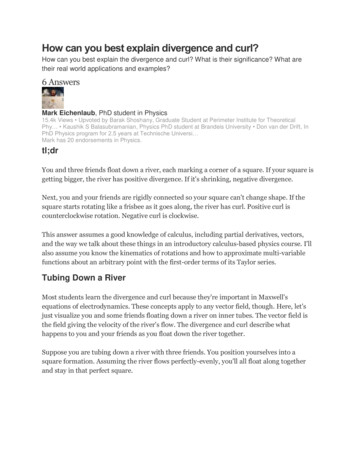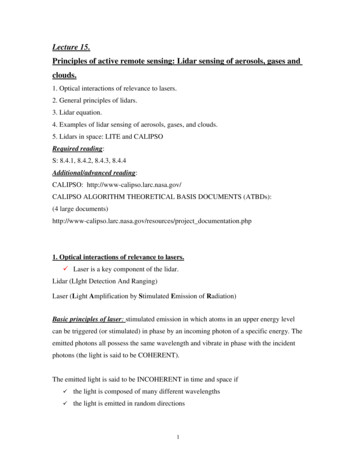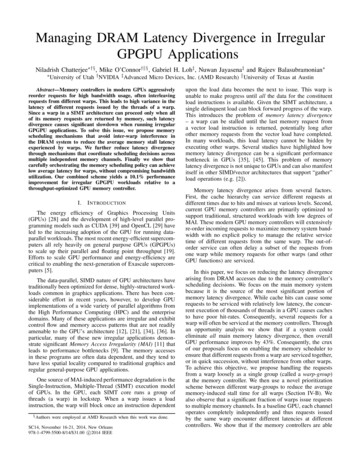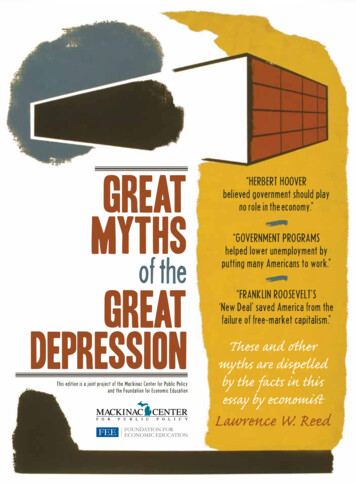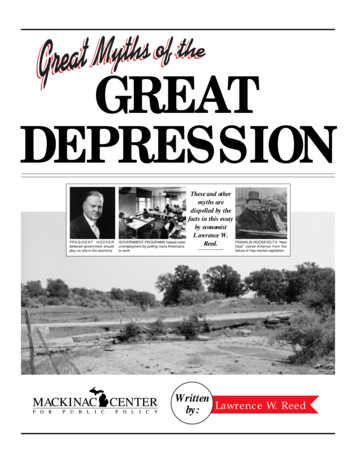
Transcription
Cotton Textiles And The Great Divergence: Lancashire, India AndShifting Competitive Advantage, 1600-1850Stephen Broadberry and Bishnupriya GuptaAbstract:We offer a new, quantitative perspective on the shift of competitiveadvantage in cotton textiles from India to Britain, centred on theinteractions between the two countries. The growth of cotton textileimports into Britain from India opened up new opportunities for importsubstitution as the new cloths, patterns and designs became increasinglyfashionable. However, high silver wages in Britain as a result of highproductivity in other tradable goods and services, meant that Britishproducers of cotton textiles could not use labour-intensive Indianproduction methods. The growth in British labour productivity that resultedfrom the search for labour-saving technical progress meant that unitlabour costs became lower than in India despite the much higher wagesin Britain. However, the full effects of the rise in British productivity weredelayed until after the Napoleonic Wars by increasing wage and rawcotton costs before supply adjusted to the major increase in demand forinputs. On balance, the effects of British protective measures wereneutral.Acknowledgements:We would like to thank Bob Allen, Nick Crafts, George Grantham, Frank Lewis,Jonas Ljungberg, Patrick O’Brien, Richard Sutch, Alan Taylor andseminar/conference participants at Berlin, Granlibakken (Clio), Kingston,Leicester (EHS), Madrid, Montreal, Venice and Warwick, for helpful commentsand suggestions. The second author is grateful to the ESRC for financialsupport under grant R000239492.
I. IntroductionDuring the early modern period, India was the world’s mainproducer of cotton textiles, with a substantial export trade. Indian textileswere exported to Britain on a large scale from the seventeenth century(Baines, 1835: 55-83; Robson, 1957: 1). By the early nineteenth century,however, Britain had become the world’s most important cotton textileproducer, dominating world export markets, and even exporting to India(Ellison, 1886: 57-70; Robson, 1957: 1-3). This dramatic change ininternational competitive advantage during the Industrial Revolution wassurely one of the key episodes in the Great Divergence of living standardsbetween Europe and Asia. However, the literature on the British cottonindustry has traditionally focused on domestic production issues, and hashad relatively little to say about interactions between India and Britain(Ellison, 1886: 14-70, Landes, 1969: 82-88; Rose, 2000: 22-37).1 To theextent that a comparative perspective has been taken at all, it has beenconventional to compare Britain with other European countries or theUnited States (Landes, 1969: 159-169; Rose, 2000: 37-56).This paper analyses the shift in competitive advantage in terms ofchanging unit labour costs, emphasising the interactions between Britainand India. The growth of cotton textile imports into Britain via the EastIndia Company from the seventeenth century opened up newopportunities for British manufacturers via a strategy of import substitutionand re-export substitution, as the new cloths, patterns and designsbecame increasingly fashionable (de Vries, 1993; Berg, 2002; Inikori,2002: 428). However, high silver wages in Britain as a result of highproductivity in other tradable goods and services, meant that Britishmanufacturers could not use labour-intensive Indian production methods.1This view is perhaps most memorably summarised by the anonymous schoolboy’sanswer to a question on the Industrial Revolution which began with the phrase “About1760 a wave of gadgets swept over England” (Ashton, 1948: 48).2
Broadberry and Gupta (2005) show that an unskilled labourer in Indiaearned little more than 20 per cent of the English unskilled wage as earlyas 1600, when Indian wages are converted to pounds sterling at theprevailing exchange rate. Low Indian wages acted as a spur to laboursaving technical progress in the British cotton textile industry. As Britishproductivity increased, a point was reached where Britain’s higher wageswere more than offset so that unit labour costs were lower in Britain andthe reversal of competitive advantage occurred. However, the shift wasdelayed in international markets during the late eighteenth and earlynineteenth centuries by rising wage and raw cotton prices in Britain as theincrease in production put pressure on labour and material input markets.The shift in competitiveness in the Indian market was delayed further bytransport costs, which continued to give Indian producers an advantage intheir home market until the 1860s (Ellison, 1886: 63; Twomey, 1983).It has been argued that the British cotton industry gained fromprotection during the eighteenth century (O’Brien et al., 1991). However,once it is recognised that the British cotton industry was innovating inresponse to a factor cost disadvantage, this argument becomes muchless persuasive. Indeed, it even becomes possible to argue thatprotection in the domestic market was, if anything, likely to delay the shiftof competitive advantage, by removing the immediate pressure ondomestic producers to innovate. In fact, it seems likely that the effects ofprotection were neutral, since there is evidence that the Calico Acts werecircumvented (Thomas, [1926]).The paper proceeds as follows. In section II we set out thequantitative dimensions of the development of the industry in the twocountries. We then examine comparative wages and productivity insection III, showing the shift in competitive advantage as productivityincreased in Britain and stagnated in India. Section IV then adds in rawcotton costs and shows how productivity and cost factors interacted to3
bring about the growing dominance of the British cotton industry in worldmarkets. Section V re-examines the issue of high wages and laboursaving technical progress, including a section on the implications forprotection. Section VI concludes.II. Development Of The British And Indian Cotton TextileIndustries1. The British cotton textile industryThere is widespread agreement that the arrival on a large scale ofIndian cotton cloth in Britain in the seventeenth century had a substantialeffect on the domestic textile industry. Indian patterns and designs quicklybecame fashionable and forced domestic textile producers to react, onthe one hand lobbying for protection, and on the other hand imitatingthrough printing on wool, linen and calico (Wadsworth and Mann, 1931:118; Thomas, 1926: 25-66). It is significant, however, that there was noattempt by domestic producers to imitate Indian labour-intensiveproduction methods, which could not have been economically viable atBritish wage rates.In fact, the cotton industry was probably first introduced into Britainby immigrants from the European continent, fleeing religious persecution.Baines [1835: 99] mentions Walloon and Dutch immigrants to East Angliain the second half of the sixteenth century. However, the cotton industrydid not take permanent root there (Wadsworth and Mann, 1931: 19-20).Rather, the industry took root in the already established textile producingregion of Lancashire at the beginning of the seventeenth century, initiallythrough the production of fustians, a combination of cotton weft and linenwarp (Wadsworth and Mann, 1931: 15; 527).The British industry remained small throughout the seventeenthcentury and the first half of the eighteenth century, since it was not yet4
competitive with Indian cotton textiles. The output of the cotton industry isusually gauged from the consumption of raw cotton, measured byretained imports (Deane and Cole, 1969: 185; Hoffman, 1965: 254-257;Farnie, 1979: 7). Table 1 shows that when figures begin at the end of theseventeenth century, raw cotton consumption was only about 2 per centof its volume at the beginning of the nineteenth century. Indeed, as lateas the 1750s, cotton consumption was still less than 5 per cent of thelevel of the early 1800s.The lack of competitiveness of the early British cotton textileindustry can be seen most clearly in the trade data of Tables 2 and 3.Trade data were collected by customs officials on a value basis, but at“official” rather than current prices. These official prices were set to reflectnormal or typical prices ruling in 1694, with great care being taken toeliminate temporary fluctuations (Schlote, 1952: 15). Although muchattention has been focused in the literature on how these official valuesprovide a misleading guide to current values of trade, particularly after thelate eighteenth century, this does not invalidate their use as indicators oftrade volumes. Indeed, Mitchell (1988: 446) quotes Flux (1899: 81) to theeffect that “(t)he official values appear to give a much better indication onthe movements in the volume of trade than one could have expected”.Certainly, the increase in the volume of both piece goods and yarnexports during the first half of the nineteenth century shown in part B ofTable 2, moves broadly in line with the official values of exports in part Aover the same period. At the beginning of the eighteenth century, Britishcotton textile exports were a mere 0.5 per cent of their level at thebeginning of the nineteenth century. By the 1750s, despite substantialgrowth, export volumes remained just 3 per cent of the level of the early1800s. In part A of Table 3, derived from the work of Davis (1954; 1962)on the regional breakdown of trade by commodity, the data on trade5
values at official prices show how British cotton textile exports were asmall fraction of the imports of cotton cloth from India before the 1780s.Worries about competition from India in the British market led topressures for protection. But it should be noted that the pressure for suchmeasures came more from producers of woollens and linens than fromthe small community of British cotton textile producers, since finewoollens and linens were the closest substitutes for printed cottons fromIndia (Baines, 1835: 106). Initial measures from 1690 took the form ofimport duties, but these were too low to make much impact on the hugelabour cost differences (Davis, 1966: 309). From 1701, however, printedcalicoes and certain other types of cotton cloth imported from India wereprohibited (Wadsworth and Mann, 1931: 117-118). The 1701 Calico Actstill allowed the importation of white cottons from India for printing withinBritain, until further legislation in 1721 prohibited these imports unlessthey were for re-export. O’Brien et al. (1991: 413-418) see theseprotectionist measures, which remained in force with variousamendments until 1774, as giving an important boost to the British cottonindustry. However, if the British cotton industry is seen as innovating toovercome a labour cost disadvantage, protection could be seen asreducing the incentive to innovate, and therefore delaying the shift ofcompetitive advantage. As we shall see later, such a situation is broadlyconsistent with the experience of the United States in the nineteenthcentury. However, in the case of Britain during the eighteenth century, it ismore likely that the protective measures were largely circumvented, as isapparent from Chaudhuri’s (1978: 278) consideration of Indian exports toBritain.By the mid-eighteenth century, Britain’s cotton producers were stillnot able to compete seriously on world markets (Baines, 1835: 81). Butthe search for labour-saving inventions, driven by the much higher wagesin Britain than India, had already begun by this time, and Timmins (1996:6
34-39) lists developments in all the main sections of preparation, spinningand weaving before the Industrial Revolution. Worthy of note are LewisPaul’s carding cylinder (1746), Lewis Paul’s spinning machine (1738) andJohn Kay’s flying shuttle (1733). It is interesting to note that the othermajor innovation before the Industrial Revolution was the Dutch or engineloom, which originated from the other high wage centre of Europe(Timmins, 1996: 36-37). However, the crucial “macro inventions” of theIndustrial Revolution period had not yet appeared, since searching for anyparticular invention does not guarantee that it will be found immediately(Mokyr, 1990; Crafts, 1977). Hence, whilst labour productivity in Britainwas higher than in India, it was still not sufficiently high to offset thehigher wages. Indeed, since wages increased more rapidly in Lancashirethan in southern England during the eighteenth century, the Anglo-Indianwage gap in cotton textiles increased substantially (Gilboy, 1934). Thisprovides an example of a general phenomenon of input prices being bidup by an increase in demand before supply has responded fully.During the second half of the eighteenth century, however, labourproductivity increased dramatically in the British cotton textile industry asa result of further labour-saving technical progress, while technology andproductivity stagnated in India. This led to a shift in competitiveadvantage, so that by the early nineteenth century, Britain was dominantin world markets, and even able to export to India. Between 1780 and1800, output grew at an annual rate of 10.8 per cent, while exportsexpanded at an astonishing 14.0 per cent per annum. During the first halfof the nineteenth century, output continued to grow at an annual rate of5.0 per cent, while exports increased at a rate of 6.3 per cent per annum.However, Britain’s conquest of world markets was hampered during theearly stages of the Industrial Revolution between the 1780s and the1820s by he high price of inputs resulting from the sudden surge in Britishdemand. This applied most obviously in the labour market, where7
shortages of handloom weavers famously led to very high earnings.However, it also affected the price of raw cotton in Britain, which reachedvery high levels in the late eighteenth and early nineteenth centuries(Mitchell, 1988: 759-760). However, as supply increased, particularly fromthe United States, the price of raw cotton in Britain fell back to the level ofthe early eighteenth century during the 1830s, and Indian producers werefaced with the full force of British competition.As current prices began to deviate substantially from official pricestowards the end of the late eighteenth century, Davis (1979) providedestimates of trade values at current prices, shown here in part B of Table3. These figures suggest that after the repeal of the protective legislation,imports exceeded re-exports by a considerable margin until the beginningof the nineteenth century. However, exports exceeded imports already bythe early 1790s.British-made cottons first broke into the export trade in the Africanand American markets during the eighteenth century, but success tendedto be limited to periods when the availability of Indian goods wasrestricted by war. Wadsworth and Mann [1931: 159-160] show that Indiangoods were still able to take market share from the British-producedcottons in Africa when the disruption of the Seven Years War ended in1763. With the struggle over American independence adding to thedifficulties of Britain’s cotton exporters, it is perhaps fortunate that fromthe 1770s technological developments made Britain competitive inEurope, finding a growing market for what were called in the trade data“Manchester cottons and velverets” (Wadsworth and Mann, 1931: 168169). As Edwards (1967: 50) notes, the ability of merchants andmanufacturers to switch flexibly between the American and Europeanmarkets was important during the period of the Revolutionary andNapoleonic Wars between 1793 and 1815. Not only was British trade withEurope frequently disrupted by the fighting on the Continent during this8
extended period, but Britain also went to war with the United Statesbetween 1812 and 1814. Inikori (2002: 444) shows that Indian cottonscontinued to share the West African market equally with British-madecottons during the second half of the eighteenth century, but thatLancashire goods pulled ahead decisively after the Revolutionary andNapoleonic Wars.The penetration of British cotton textile exports into the Indianmarket proceeded more slowly, however, since Indian producers retaineda transport cost advantage which they lacked in competition between thetwo countries in Africa, America or Europe. To estimate Britain’s share ofthe Indian market, it is necessary to make assumptions about cottonconsumption in India. Ellison [1886: 63] assumes cotton consumption of2½ lb per head of population, which leads to the estimates of total cottonconsumption in Table 4. This can be married up with reliable data onBritish exports to India to obtain estimates of Britain’s market share.Ellison’s data suggest that Indian producers supplied a larger share oftheir home market than British producers until at least the 1860s. Twomey(1983: 46, 53) makes similar assumptions to estimate the share of Britishexports in the Indian market as rising from 10 per cent in 1850 to a peakof 60 per cent in 1880-84 before falling back to 50 per cent by 1910-14.2. The cotton textile industry in IndiaBefore the dramatic rise of Lancashire in the late eighteenth andearly nineteenth centuries, the world’s most important cotton textileindustry was located in India (Robson, 1957: 1). Chaudhuri (1978: 238)argues that India’s competitiveness in this industry can be explained byan abundant supply of skilled labour, with specialised tacit knowledgebeing passed down through the generations in classic Marshallian9
fashion.2 Occupations related to the production of particular types oftextiles were caste-based and led to regional specialisation. Raw cottonwas available locally and regional varieties often had a crucial impact onthe type of cloth produced. Although spinning and weaving activities werewidely dispersed throughout the country, regional specialisation was akey aspect of the Indian cotton textile industry. Coarse cloth wasproduced for the local market and was spread across all regions. Finecloth was produced for interregional and international markets, mainly inthe four regions of Gujarat, the Punjab, the Coromandel Coast andBengal (Chaudhuri, 1978: 243).The Gujarat cotton industry exported largely to the Red Sea ports,while exports from the Punjab went overland to Afghanistan, East Persiaand Central Asia and by river and sea to the Persian Gulf (Chaudhuri,1978: 243-245). Before the growth of the European trade, theCoromandel industry exported mainly to south-east Asia, while Bengalsupplied upper India. From the seventeenth century, substantialquantities of Indian cotton cloth were exported to Europe, particularlythrough the English East India Company (EIC) and the Dutch United EastIndia Company (Verenigde Oostindische Compagnie or VOC). TheEuropean companies set up trading posts along the coast andencouraged the settlement of weavers. This was particularly true of theCoromandel Coast in the south of India (Ramaswamy 1985: 120-121). InBengal, textile production was primarily a domestic rural industry.Although there were urban centres of production, weavers showed muchless mobility than in the Coromandel (Chaudhury 1995: 158).Part A of Table 5 shows the number of textile pieces exported toBritain between the 1660s and 1750s by the EIC from Bombay (theGujarat trade), Madras (the Coromandel Coast trade) and Bengal,2Marshall [1920: 225] famously noted that “The mysteries of the trade become nomysteries; but are as it were in the air.”10
together with the data on textile exports to Europe via the VOC. Althoughthe textile data include small amounts of silk goods and mixtures of silkand cotton, they are dominated by cotton cloth. Total textile exports fromthese three key centres of the Indian cotton textile trade to Britain show astrong upward trend from the 1660s to the 1680s, followed by a sharpdownturn due to political conflict and war with the Mughal Empire. Asecond downturn in the first decade of the eighteenth century can beexplained by the introduction of measures to protect British textileproducers, together with bullion shortage and war (Chaudhuri, 1978:295). However, ways were found around the protective measures andIndian textile exports to Britain fluctuated around 600,000 to 800,000pieces for the rest of the first half of the eighteenth century. Part B ofTable 5 picks up the story from the 1770s to the 1790s, but with theGujarat trade passing through Surat rather than Bombay. Note that Indianexports to Britain continued to thrive during this period.Note, however, that the regional balance of the Indian export tradeto Britain changed substantially between the seventeenth and eighteenthcenturies. Whereas Bombay and Madras were clearly more importantduring the seventeenth century, Bengal became the dominant supplier oftextiles to the EIC during the eighteenth century. The decliningimportance of the Coromandel Coast as a supplier partly reflected thedisruption caused by political conflict, particularly during the MughalMaratha wars (Arasaratnam, 1986: 153). However, Chaudhuri (1978:296) also notes a relative cheapening of Bengal cottons, which suggeststhat the shift in competitive advantage between India and Britain wasforeshadowed by a regional shift in competitive advantage within India.Exports via the VOC were generally lower than via the EIC, and exportsby the French and Danish companies were lower again (Morineau, 1999:252, 266).11
Table 6, taken from Twomey (1983), shows Indian cotton textileexports during the late eighteenth century and the first half of thenineteenth century. The figures for Bengal in the 1790s match well withthe figures from Table 5, although the higher figures for total Indiasuggest that the three centres account for only about half the trade. Table6 suggest that there was a sharp decline in Indian cotton textile exports tothe British market only from the 1790s, which accords with the pattern ofBritish imports in Table 3. Note, however, that the decline in total Indianexports to all markets was substantially slower.3. Textile prices and the world marketOur explanation of the shift in competitive advantage relies on theexistence of an integrated world market in cotton textiles. Althoughtransport costs provided local producers with a limited amount of shelterfrom international competition in local markets, even with a relatively lightproduct such as cloth, competitive forces also clearly stopped local pricesfrom getting too far out of line with world market prices. This was muchless true of grain prices in the early modern period, since grain was muchmore expensive to transport on account of its high weight-to-value ratio(Broadberry and Gupta, 2005).Textile prices and grain prices for England during the period 15001850 are shown in Figure 1, based on Phelps Brown and Hopkins (1981:44-59). The relative price of textiles clearly trended downwards over theperiod as a whole, as agricultural prices increased more rapidly thantextile prices. Note that English textile prices showed no trend increase ordecrease in nominal terms during the seventeenth and eighteenthcenturies, which amounted to a substantial real price decline (Shammas,1994). This is the context in which we need to assess what washappening to textile prices in India, with prices on world markets settinglimits to the prices that could be paid to Indian producers. As already12
noted in the discussion of lobbying for protection in Britain, there was aclear appreciation amongst textile producers of competition betweentypes of cloth, with fine woollens and linens seen as close substitutes forprinted cottons (Baines, 1835: 106). Hence the Indian export pricescharted in Figure 2 for the period 1665-1759 show little upward trend.However, they also indicate a fairly constant differential between thehigher prices in Madras and Bengal than in Bombay, reflectingdifferences in the type of cloth produced in the different regions. Theconstraint imposed by the price that could be obtained on the Englishmarket is illustrated by the fact that after 1760, the East India Company’soffer price to the weavers in Bengal at times fell short of the weavers’cost-determined asking price, so that supply to the EIC fell short ofdemand (Hossain, 1988: 55).It seems likely that, against this generally competitive background,the EIC enjoyed monopsony power in at least some regions of India insome periods, due to the scale of its operations. Nevertheless, thegeneral framework of analysis is one of international competition within anintegrated world market for cotton textiles. As technical progress in Britainput downward pressure on cotton textile prices, Indian producers found itincreasingly difficult to compete, and competitive advantage in cottontextiles shifted from India to Britain. As Mitra (1978: 193) put it, “In 1818,the Dacca factory was closed down. It was not the freight, nor theprotective duty which prompted the Court to abandon it in 1818, but thesharp reduction in prices of English cotton goods of a similar descriptionand the fine piece-goods of Bengal increasingly lost their market.”13
III. Wages And Productivity In India And Lancashire1. Anglo-Indian wage differences in cotton textilesThe cotton textile industry adds value to raw cotton, using labourintensive production processes. Hence competitiveness on world cottontextile markets depends largely on comparative unit labour costs, givenby the ratio of comparative money wages measured in a commoncurrency and comparative labour productivity in volume terms. In thissection we compare the wages of cotton textile workers in Lancashire andIndia. Chaudhuri (1978: 237) notes the views of an anonymous authorwriting in 1701 that the same amount of labour as would cost a shilling inEngland may be had for two pence in India. To what extent did this six-toone wage differential exist in cotton textile production, and how did it varyover time?Broadberry and Gupta (2005) show that the money wages ofunskilled and skilled labourers in India were already much lower than inBritain by the end of the sixteenth century, when compared at prevailingexchange rates. Since currencies at this time can be compared on thebasis of their silver content, this is labelled the silver wage. Although thesilver wage was much higher in Britain than in India, providing greatercommand over tradable goods, it should be noted that the price of nontradable goods was also much higher in Britain. Hence, differences in thegrain wage, defined as the silver wage divided by the price of grain, theprincipal foodstuff, were much smaller. Differences in living standards (orreal consumption wages) lie somewhere between the limits set by silverwage differences and grain wage differences.Table 7 presents a comparison of earnings in the cotton industrybetween 1680 and 1820. The Indian earnings are collected from a varietyof sources for the Coromandel and Bengal. Data for the early period aretaken from several studies of the handloom industry in south-easternIndia, while data for the later period are mainly from Bengal. This is in line14
with the regional shift of production for export discussed earlier. TheLancashire earnings for 1770 are taken from the authoritative study ofWadsworth and Mann [1931], and derive originally from the work of ArthurYoung, based on the weekly earnings of a handloom weaver operating asingle loom, with some assistance from his wife and children.3 The Indiandata for 1770 are derived from an estimate of the monthly earnings of aloom operated by two men with the assistance of their wives andchildren.4 These data put the Lancashire wage at 600 per cent of theIndian wage, consistent with the six-to-one differential noted byChaudhuri’s (1978: 237) anonymous tract author.Working back from 1770, we take the 1680 figure for India fromBrennig’s (1986) study of the Coromandel textile trade in the lateseventeenth century. The weekly data are derived as one quarter of theestimated monthly earnings of a master weaver operating a single loomwith the help of an assistant. The weaver would also have been assistedin ancillary tasks by his wife. For Lancashire, we have used Gilboy’s(1934) estimate of the daily wage of a craftsman, assuming a six-dayweek.Working forward from 1770, we take the earnings in Lancashire forcirca 1790 from Gilboy (1934: 280-287). The figure used here is for skilledworkers. Wood (1910) suggests even higher earnings for handloomweavers during the late 1790s, due to a substantial imbalance betweenthe spinning and weaving sections of the industry at this time, following anumber of dramatic improvements in spinning technology but before thesuccessful introduction of the powerloom. However, Gilboy (1934)suggests a substantial increase in earnings during the course of the3These figures for the earnings of English weavers are also used by Parthasarathi(1998: 83-84).4Since all earnings are attributed to male weavers rather than allocated betweenweavers and other family members, the true wage of an individual weaver is, ifanything, overstated in these sources.15
1790s, and spinners’ earnings were substantially lower. Since the wagesof handloom weavers increased much more slowly in India, the Englishwage as a proportion of the Indian wage increased. For 1820, theLancashire earnings data are taken from Wood (1910: 127) and refer toall cotton operatives, including factory workers as well as handloomweavers. With handloom weaving now being threatened by factoryproduction, and with a general rebalancing of supply and demand in thelabour market, English wages fell back in cotton textiles.5 Mitra (1978:128-129) shows that the wages of Indian cotton spinners remainedconstant in money terms between 1790 and 1820, so that the Englishwage fell back to 517 per cent of the Indian level.2. Anglo-Indian productivity differences in cotton textilesDirect estimates of the level of labour productivity in cotton textileproduction for both
changing unit labour costs, emphasising the interactions between Britain and India. The growth of cotton textile imports into Britain via the East India Company from the seventeenth century opened up new opportunities for British manufacturers via a strategy of import substitution and re-export substitution, as the new cloths, patterns and designs


